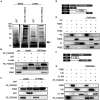Mycobacterial protein PE_PGRS30 induces macrophage apoptosis through prohibitin 2 mitochondrial function interference
- PMID: 36778852
- PMCID: PMC9911437
- DOI: 10.3389/fmicb.2023.1080369
Mycobacterial protein PE_PGRS30 induces macrophage apoptosis through prohibitin 2 mitochondrial function interference
Abstract
PE_PGRS30 belongs to the PE_PGRS protein family and is characterized by a conserved Pro-Glu (PE) domain and a typically polymorphic GC-rich sequence (PGRS) domain. PE_PGRS30 is a virulence factor of Mycobacterium tuberculosis that induces macrophage cell death. We found that RAW264.7 cells and murine alveolar macrophages underwent apoptosis in response to PE_PGRS30. The host protein prohibitin 2 (PHB2) was identified as a target molecule. PE_PGRS30 and PHB2 interact via the PGRS domain and mitochondrial targeting sequence, respectively. PHB2 overexpression reduced macrophage apoptosis in response to PE_PGRS30. PE_PGRS30 co-localized with PHB2, not in mitochondria, but in lysosomes. The maintenance of mitochondrial structure by PHB2 was impaired in response to the PGRS domain. These results indicated that PE_PGRS30 reduces PHB2 in mitochondria, resulting in mitochondrial dysfunction and cellular apoptosis.
Keywords: PE_PGRS30; PHB2; apoptosis; macrophages; mitochondria; tuberculosis.
Copyright © 2023 Matsumura, Takaki and Kirikae.
Conflict of interest statement
The authors declare that the research was conducted in the absence of any commercial or financial relationships that could be construed as a potential conflict of interest.
Figures






Similar articles
-
Impact of protein domains on PE_PGRS30 polar localization in Mycobacteria.PLoS One. 2014 Nov 12;9(11):e112482. doi: 10.1371/journal.pone.0112482. eCollection 2014. PLoS One. 2014. PMID: 25390359 Free PMC article.
-
PE_PGRS30 is required for the full virulence of Mycobacterium tuberculosis.Cell Microbiol. 2012 Mar;14(3):356-67. doi: 10.1111/j.1462-5822.2011.01721.x. Epub 2011 Dec 13. Cell Microbiol. 2012. PMID: 22050772
-
The PGRS domain is responsible for translocation of PE_PGRS30 to cell poles while the PE and the C-terminal domains localize it to the cell wall.FEBS Lett. 2014 Mar 18;588(6):990-4. doi: 10.1016/j.febslet.2014.01.059. Epub 2014 Feb 11. FEBS Lett. 2014. PMID: 24530527
-
PE_PGRS: Vital proteins in promoting mycobacterial survival and modulating host immunity and metabolism.Cell Microbiol. 2021 Mar;23(3):e13290. doi: 10.1111/cmi.13290. Epub 2020 Dec 1. Cell Microbiol. 2021. PMID: 33217152 Review.
-
PE_PGRS proteins of Mycobacterium tuberculosis: A specialized molecular task force at the forefront of host-pathogen interaction.Virulence. 2020 Dec;11(1):898-915. doi: 10.1080/21505594.2020.1785815. Virulence. 2020. PMID: 32713249 Free PMC article. Review.
Cited by
-
Temporal Profiling of Host Proteome against Different M. tuberculosis Strains Reveals Delayed Epigenetic Orchestration.Microorganisms. 2023 Dec 16;11(12):2998. doi: 10.3390/microorganisms11122998. Microorganisms. 2023. PMID: 38138142 Free PMC article.
-
Mycobacterium tuberculosis PE_PGRS38 Enhances Intracellular Survival of Mycobacteria by Inhibiting TLR4/NF-κB-Dependent Inflammation and Apoptosis of the Host.Biology (Basel). 2024 Apr 30;13(5):313. doi: 10.3390/biology13050313. Biology (Basel). 2024. PMID: 38785795 Free PMC article.
-
Prohibitins in infection: potential therapeutic targets.Future Microbiol. 2025 Mar;20(4):345-355. doi: 10.1080/17460913.2025.2459530. Epub 2025 Jan 29. Future Microbiol. 2025. PMID: 39881489 Review.
-
Epigenetic Mechanisms Induced by Mycobacterium tuberculosis to Promote Its Survival in the Host.Int J Mol Sci. 2024 Nov 2;25(21):11801. doi: 10.3390/ijms252111801. Int J Mol Sci. 2024. PMID: 39519352 Free PMC article. Review.
-
Evolution of the PE_PGRS Proteins of Mycobacteria: Are All Equal or Are Some More Equal than Others?Biology (Basel). 2025 Feb 28;14(3):247. doi: 10.3390/biology14030247. Biology (Basel). 2025. PMID: 40136504 Free PMC article. Review.
References
-
- Abo-Kadoum M. A., Assad M., Ali M. K., Uae M., Nzaou S. A. E., Gong Z., et al. . (2021). Mycobacterium tuberculosis PE17 (Rv1646) promotes host cell apoptosis via host chromatin remodeling mediated by reduced H3K9me3 occupancy. Microb. Pathog. 159:105147. doi: 10.1016/j.micpath.2021.105147, PMID: - DOI - PubMed
-
- Balaji K. N., Goyal G., Narayana Y., Srinivas M., Chaturvedi R., Mohammad S. (2007). Apoptosis triggered by Rv1818c, a PE family gene from Mycobacterium tuberculosis is regulated by mitochondrial intermediates in T cells. Microbes Infect. 9, 271–281. doi: 10.1016/j.micinf.2006.11.013, PMID: - DOI - PubMed
-
- Basu S., Pathak S. K., Banerjee A., Pathak S., Bhattacharyya A., Yang Z., et al. . (2007). Execution of macrophage apoptosis by PE_PGRS33 of Mycobacterium tuberculosis is mediated by toll-like receptor 2-dependent release of tumor necrosis factor-alpha. J. Biol. Chem. 282, 1039–1050. doi: 10.1074/jbc.M604379200, PMID: - DOI - PubMed
LinkOut - more resources
Full Text Sources
Miscellaneous

